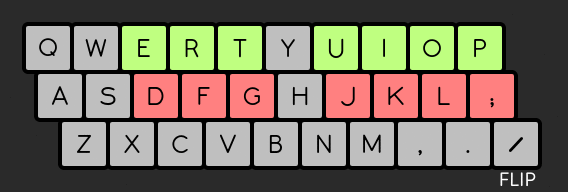The better keyboard layout
your fingers already know

The 10 most frequent letters in English are ETAOINSRHL. This layout gets most of those letters onto the home row while making use of existing muscle memory. According to Carpalx, QWERTY-Flip scores about as well as the famous Dvorak layout, but while Dvorak is very hard to learn, with QWERTY-Flip you'll be up and running immediately.
If you study QWERTY and English letter frequencies for long enough there's a good chance you'll notice a much better keyboard layout exists where the top and middle rows are swapped whenever the top key is used more than the middle key. This has been discovered independently over and over again (and often given unimaginative names like QWDFGY, ASERT, or ASERTH), but most people who discover this don't stop there. Even though Carpalx gives QWERTY-Flip a similar score (2.061) to Dvorak (2.047), that score can be improved upon with more tweaks, so people end up making better scoring but much harder to learn layouts. I think that's a shame because this layout has a unique advantage over its competitors. Since your brain just has to learn one rule to apply to many keys, it's very easy to learn and takes very little conscious effort to switch back and forth with normal QWERTY. Once more keys move, you lose these advantages as your brain has to learn different rules for every moved key (see Colemak for instance).
There may be more optimal layouts, but none improve QWERTY so much while being so trivial to learn. I think this makes it the most practical layout for most people to learn after QWERTY. I made this page and layout files because I want to promote the idea and provide a definitive home for related resources.

I prefer the simplicity of QWERTY-Flip which brings 8 of the top 10 letters onto the home row, but because I suspect some people may want to try and get the remaining 2, I also made Spin and Twist. Each adds one of the remaining top 10 letters to the home row, at the cost of making it harder to re-use existing muscle memory. Whether either or both of these are worth using is up to you.
Download the layout files for your OS from the QWERTY-Flip git repo.
QWERTY-Flip was discovered rediscovered by Nick Gravgaard in August 2020.
All text and images on this page are copyright Nick Gravgaard and licensed under a Creative Commons Attribution 3.0 Licence.
This page was first uploaded on 2021-01-03 and last updated on 2021-03-06.